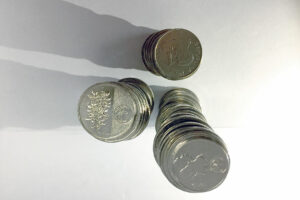




Quarterly Economic Growth Release: More BSP cuts to come
 DOWNLOAD
DOWNLOAD

Monthly Economic Update: Fed catches up
 DOWNLOAD
DOWNLOAD

Inflation Update: Steady and mellow
 DOWNLOAD
DOWNLOAD


Peso may trade sideways ahead of offshore data

THE PESO could trade sideways this week depending on any data releases from abroad, and until the Bangko Sentral ng Pilipinas (BSP) changes its sentiment on pausing rate hikes.
Philippine financial markets were closed on Friday for a regular holiday in observance of Eid’l Fitr.
“No major local data [this] week so [the peso] will likely take cues from global events,” a trader said in a Viber message.
Rizal Commercial Banking Corp. Chief Economist Michael L. Ricafort said in a Viber message that the scheduled releases from the US that could affect the peso on April 25 include the Non-Manufacturing Index, gauges of US home prices, new home sales data, and the Conference Board Consumer Confidence Index.
The April 26 releases of the US trade deficit and durable goods orders could also be taken into account, Mr. Ricafort said, as well as the April 27 releases of jobless claims, gross domestic product (GDP), and pending home sales.
US personal income and spending, personal consumption expenditures (PCE), which is an inflation gauge preferred by the US Federal Reserve, and the University of Michigan’s Sentiment Index are also scheduled to be released on April 28.
The peso could also depreciate this week as BSP Governor Felipe M. Medalla said in an economic briefing last week that the Monetary Board might consider pausing its tightening cycle at its May 18 meeting while the US Federal Reserve continues to raise its own, the trader added.
“We’re probably near the end [of our tightening cycle]. We’re probably [considering] pausing at the next meeting because the [month-on-month] inflation prints are very good. If April turns out to be another very low inflation month, so that’s three good points in a row, then we are in a position to pause,” Mr. Medalla said.
The Philippine Statistics Authority will release April inflation data on May 5.
Headline inflation slowed to 7.6% in March from 8.6% in February, bringing the first-quarter average to 8.3%, still well above the central bank’s full-year forecast of 6% and the 2-4% target.
The Monetary Board has raised borrowing costs by 425 basis points (bps) since May last year — including the 25-bp hike last month — bringing the benchmark rate to 6.25%, the highest since 2007.
The central bank chief also signaled that they may cut policy rates this year if inflation eases further for the next six months.
Meanwhile, the Fed has hiked borrowing costs by a total of 475 bps since March 2022, bringing its key rate to a range between 4.75% and 5%
For this week, the trader sees the peso moving between PHP 55.50 and PHP 56.50 per dollar. Mr. Ricafort expects a trading range of PHP 55.70 to PHP 56.20. — By Aaron Michael C. Sy
This article originally appeared on bworldonline.com





 By BusinessWorld
By BusinessWorld